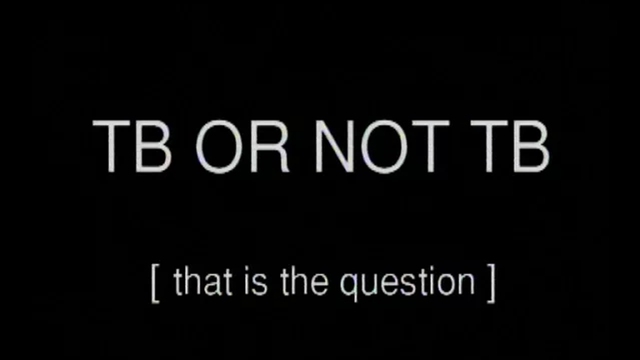TB OR Not TB
An engaging examination of a society gripped by disease
 We know what TB is caused by : a germ, Mycobacterium tuberculosis. But what we don't know is why some people in a given location develop the disease and some don't, even if they've been infected.
We know what TB is caused by : a germ, Mycobacterium tuberculosis. But what we don't know is why some people in a given location develop the disease and some don't, even if they've been infected.
While TB can affect old, young, rich or poor, it's more common in developing countries. Here, other fatal diseases like HIV/AIDS help TB in its claim on human life. The HIV virus weakens immune systems, often leading to opportunistic diseases --pneumonia, meningitis, and of course, TB. Studies show that sufferers are primarily 15-45 years of age, and are those who have a prime responsibility to their family. Cynthia Voyi was worried her baby had TB. The baby was checked, and was safe --from TB. But Cynthia turned out to be HIV positive. She contracted it from the same man who got her pregnant. Now, Cynthia dreams of a new life, which she may never achieve. "I want to stay away from him...if I can work and have a job, I can live with my children. These tablets are going to make me better...I am just trying to be well. To get my life back."
Ram Kadkha, a student in Nepal, talks about the high cost of treatment drugs for the disease while at his mother's hospital bedside. He has already lost his father to the disease. In this first interview, his mother had been suffering TB for two years. "Doctor has counselled me to buy third line drugs. But it's so expensive...so now second line drugs are used for her. But she is not feeling well." Two years later, Ram buried his mother. "She forgot to breathe, and she took leave from this world forever." We visit him 5 months after his mother's death and after he himself fell victim to TB. Ram looks about 10 years older, having himself just finished drug treatment for TB. He knows his time is limited, and feels strongly that international organisations must get involved and do more to bring medicines to his people.
We ask Dr. Thomas Frieden of the WHO's Southeast Asia headquarters to explain the WHO's most recent slogan, 'Heath for all by the year 2000'. "No comment. Next question." Just 100 metres away from Dr. Frieden's work lie the shanties of New Delhi's slum. A building with its back to those who need the most help. Here, medicine costs about 500 rupees a month, but that's much more than anyone can afford. And the WHO looks away.
Multiple Drug Resistant (MDR)TB is common in Russian and Norwegian prisons. It's been associated with conditions in concentration camps and Nazism. Jews were used as 'guinea pigs' for TB treatments and were often given many different drugs, thus creating a form of TB that is immune to them all. The same problem exists in Bombay, where the treatments for TB are available from any local chemist. If one can afford the drugs, the next problem is getting the right drug and dosage. With MDR TB on the rise, it becomes harder to find a cure for the disease. The world started the 20th century with TB rates rapidly declining. We've ended with 3 million claimed each year, and the death toll is rising.
Produced by Sotfilm
FULL SYNOPSIS
